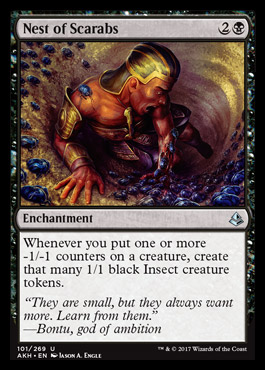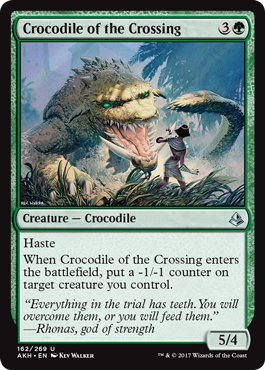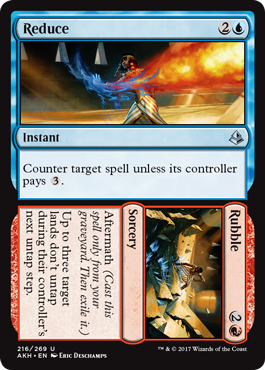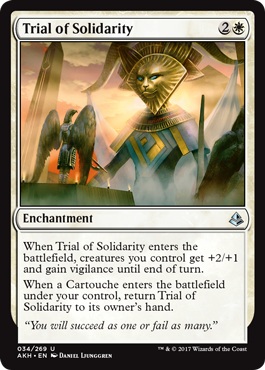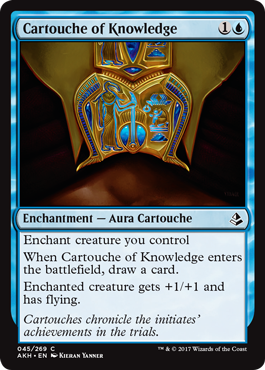Welcome back to my exploration of Amonkhet’s mechanics in Limited. Last week I broke down embalm, exert, and cycling. Now it’s time to look at -1/-1 counters, aftermath, and trials/cartouches.
-1/-1 Counters
Negative creature counters show up a lot less often than the positive counters we’re used to seeing. There are many reasons why, but here’s a big one: Negative counters are more powerful and format-warping than +1/+1 counters. When R&D breaks out the -1/-1 counters, that’s a big deal.
Think of it this way: positive counters are like auras while negative counters are like removal. Building up your own creatures is useful in Limited, but putting multiple cards into one card’s worth of board presence is an inherent disadvantage. Shrinking opposing creatures carries little risk of using multiple cards for one effect. Yes, you can shrink a big blocker then trade off a small creature for it, but you control when that happens and can decde whether that’s the best play you can make. Basically, you aren’t risking a blowout when you try to put negative counters on an opposing creature the way you are with positive counters or auras on your creatures.
Negative counters favor more controlling decks. They manage the size of your opponent’s board, making it easier to hold off attackers with your blockers. Shrinking blockers can also be good in an aggressive deck, but that’s true of removal generally. Removal is good in all decks, but more necessary in control decks. As a soft form of removal, -1/-1 counters push the format slower.
The spoiler has shown a few cards that add benefits to distributing -1/-1 counters. I expect these cards to be pretty good, because they reward you for doing something you already want to do. If there are enough ways to throw around negative counters, an engine card or two can go a long way. But there’s another interesting twist to -1/-1 counters that also make these engines better:
Green offers some efficient creatures that put negative counters on your own creatures as a drawback. That seems great to me, esepcially in sealed where small creatures have less value as the game goes on. You aren’t losing much shrinking a 2/2 or killing off a token. This reverse use of negative counters suggest R&D tried to make the mechanic more aggressive than it usually is, but it also opens up the removal risk usually associated with positive counters. If I shrink a 2/2 to play CrocoCross and you kill the 5/4, that hurts me a lot. Put me in the camp of preferring to put those -1/-1 counters on creatures I don’t control.
Aftermath
The aftermath mechanic is a new twist of split cards that’s actually just a different version of flashback. That’s great because flashback is amazing in Limited. So are split cards, but the “one now, another later” nature of aftermath reduces their flexibility. Instead of getting two halves that can be useful in a variety of situations, we get one big effect and another that might be useful as well. All of these cards look very powerful for Limited, especially sealed, where games go long and splashing extra colors is generally a good idea.
An expensive Mana Leak is probably good in Amonkhet draft, which looks controlling, and definitely will be in sealed. Do you care about the Rubble half? If you have a sweet Izzet tempo deck, you might. If you’re stuck in a sealed control mirror, your Grixis deck might find a way to eke out victory with a well-timed Rubble as well. The key is, the back half is totally free. You have to pay for it, but the longer the game goes, the more time you’ll have to find a good use.
Flashback is very powerful. Don’t sleep on these aftermath cards. They will all be good, and the ones that seem pretty good initially will be incredibly powerful.
Trials and Cartouches
So here we have a strange toolbox of global enchantments and auras. You want me to put a bunch of these in my Limited deck? They better be pretty good. Here’s the problem: it is hard to make enough room in your Limited deck a bunhc of non-creature spells, especially when some of them are auras that need creatures to be cast upon. The better trials will be ones that work well with a lot of creatures.
That’s pretty useful. It’s overcosted if you never pick it up with a cartouche, but still does what you want to be doing in a white deck full of creatures. Playing one of these could work well, with a couple cartouches to fill combat trick slots that offer long-game value with the trial. But remember this: a normal Limited deck will have maybe seven slots for non-creature, non-land cards. If you pick up two or three good removal spells, how many trials and cartouches can you make room to play? Maybe embalm helps provide enough creatures to make room for a few extra trials. I know I’ll be happy to play this beautiful cartouche in any deck with creatures:
“Draw a card” goes a long way. This is a great common aura. But overall, you should try to limit trials and cartouches in your deck to ones that stand on their own. If you manage to cobble together some recursive value, that’s nice. A bad sealed pool might require digging deep for value. I’m not sure you want to draft the “cartouche” deck, though.
Wrapping it Up
So what do we know about Amonkhet Limited from looking at its mechanics? The set looks to be slow and grindy. Creatures are more likely to shrink as the game goes long than they are to grow. There’s room for nonsense with a bunch of enchantments. Exert is a heavily skill-testing mechanic that will help stronger players win more often. Cycling and shrinking creatures mean long games can still end quickly once you draw into the right cards. Draft will be complex and take a while to figure out. Sealed will be slow and fun. I can’t wait to get to Grand Prix Richmond next month!
Carrie O’Hara is Editor-in-Chief of Hipsters of the Coast.


